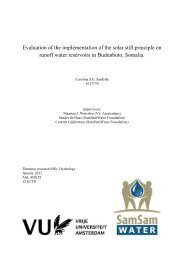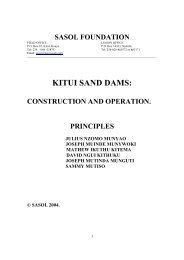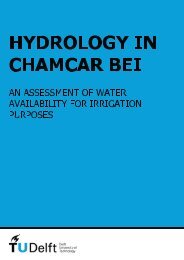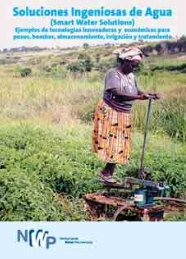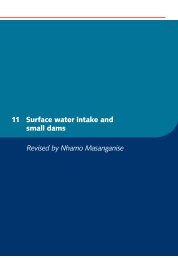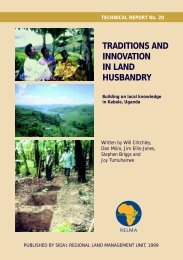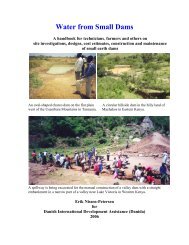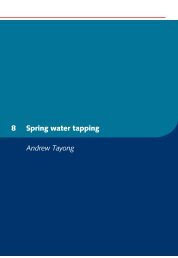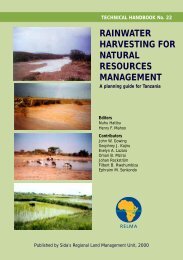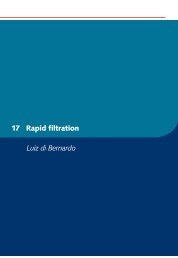Hydrogeology and siting of micro-dams around Léo Burkina Faso
Hydrogeology and siting of micro-dams around Léo ... - SamSamWater
Hydrogeology and siting of micro-dams around Léo ... - SamSamWater
Create successful ePaper yourself
Turn your PDF publications into a flip-book with our unique Google optimized e-Paper software.
<strong>Hydrogeology</strong> <strong>and</strong> <strong>siting</strong> <strong>of</strong> <strong>micro</strong>-<strong>dams</strong> <strong>around</strong> <strong>Léo</strong>, <strong>Burkina</strong> <strong>Faso</strong>14 June 2010It can clearly be seen that there is a difference in the groundwater level between the shallowscoopholes <strong>and</strong> the two deeper wells. This shallow groundwater table is high near the surface waterupstream <strong>of</strong> the dam <strong>and</strong> slowly deepening downstream. The <strong>micro</strong>-dam is clearly recharging thisshallow groundwater table. Without a dam it would be lower, or possibly non existing anymore.In the two deeper wells a second (deeper) water level is visible. The water is 4 to 5 meters deeper thanthe shallow groundwater table. These wells probably abstract water from the weathered hard rock.Based on this single measurement it cannot be said if there is any connection between the waterlevels in these two wells, but this is likely. Both <strong>of</strong> them were in use at the time <strong>of</strong> measurement whichcan have a significant effect on the water level. Periodical measurements as planned (paragraph 4.8)should give more information on this.The influence <strong>of</strong> the <strong>micro</strong>-dam on the water level in the deeper wells is not as clear as it is on theshallow groundwater table. It is however likely that the shallow groundwater slowly percolates down<strong>and</strong> recharges the weathered hard rock aquifer were these deeper wells are in.With the measurements <strong>of</strong> the scoopholes <strong>and</strong> wells a cross-sectional pr<strong>of</strong>ile was also created. Forthis pr<strong>of</strong>ile only the measurements a few meters downstream <strong>of</strong> the dam were used, as well as thewell <strong>and</strong> borehole North <strong>of</strong> the <strong>micro</strong>-dam. During the field visit the water level in the borehole wasnot measured. The borehole was properly closed <strong>and</strong> bacteriological safe so no attempts were madeto open it for a measurement <strong>and</strong> risking polluting it. The depth <strong>and</strong> water level are based on thedrilling logs (CREDO / BESER Sarl, 2009). Figure 17 shows the cross-sectional pr<strong>of</strong>ile with the measuredwater levels <strong>and</strong> the geological information from the drilling log <strong>of</strong> the borehole.Figure 17 Cross-sectional pr<strong>of</strong>ile along the river at Sanga. The brown line is the groundlevel,the blue line the shallow groundwater table. The purple line the groundwater in the deeperwells. The numbers correspond to the well numbers in Figure 15.This pr<strong>of</strong>ile shows the shallow groundwater table (blue line) in the scoopholes increases in leveltowards the sides.It is possible, but not certain, that the weathered hard rock aquifer at the deeper well near the dam(nr. 1) <strong>and</strong> the old well near the road (nr .7) is hydraulically connected (purple line). As both wells areh<strong>and</strong>-dug they probably get their water from the weathered hard rock layer, this corresponds with thedrill log from the borehole 100 m away.The borehole in the village (at the far right side <strong>of</strong> the figure) is in a third aquifer with a different watertable (red line). The drilling log <strong>of</strong> this borehole shows that the borehole is drilled into the fracturedgranite aquifer.4.3 Water quality <strong>around</strong> the Sanga <strong>micro</strong>-damNo thorough analysis was done on water quality. Only electrical conductivity (EC) <strong>and</strong> temperaturewere measured once at each scoophole <strong>and</strong> well. Both temperature <strong>and</strong> EC are probably (largely)influenced by whether or not the scoophole or well was in use, but they can give an indication for thewater quality <strong>and</strong> local differences between water points.16




